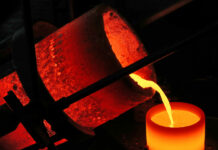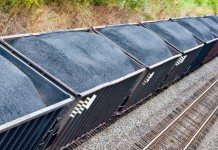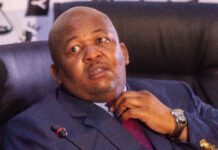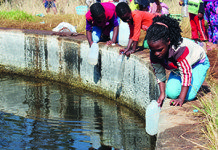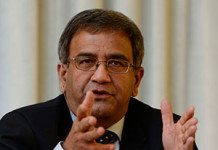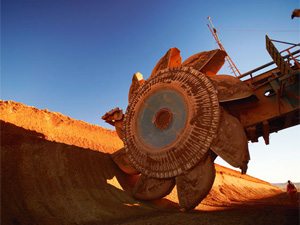
[miningmx.com] – AT THE BEST of its times, West Africa’s iron ore sector has been characterised by a flurry of investments from majors and minors alike.
The region’s resources, considered to be the world’s largest untapped iron ore deposits, have won over stalwarts like Vale and Rio Tinto, which have set up operations in Guinea; and in Cameroon, Australian miner Sundance and AIM-listed West African Minerals have pegged their stakes.
Other British-listed miners have also hit the scene, including African Minerals and London Mining in Sierra Leone, which have advanced their operations to export level, while Glencore’s partnership with local outfit Zanaga, called Zanaga Iron Ore, is cutting its teeth in the Republic of Congo.
Despite the sector’s boasts of high grade iron ore deposits and low processing costs, the City’s mood and general investor appetite for assets in the sector is waning.
Several mining companies are battling to access equity and debt financing for their projects.
Years down the line from those first investment steps, and billions of dollars later, it’s seems a long way off before many will be able to crack open the champagne. Something is amiss.
“The wave of positive sentiment that carried all projects along has long gone and there is now only limited investor appetite for the UK-listed iron ore companies in West Africa, and then only amongst the specialists,’ said London-based Hunter Hillcoat, a mining analyst at Investec.
“The depressed share prices reflect the sense of apathy from the market. It is not just UK-listed miners, but others with exposure to the West African iron ore sector too,’ he said.
“The key issue is that all of the companies require funding in one form or another; even existing producers still require financing in order to reach the next stage of their development. This has not been helped by the generally disappointing progress that the new producers have made in bringing on their projects,’ he said.
“Without trying to diminish the very real challenges that they have overcome, they have generally been continual disappointers in terms of meeting their guidance in terms of production, ore quality and costs, both operating costs and capital requirements.’
A looming market oversupply for iron ore as well as lower demand and tightening credit conditions in China, which is the world’s biggest iron ore consumer, have forced iron ore prices down.
The broad investment view has long been that prices would continue to track down, but the fall has been more severe than most would have expected, Hillcoat said. The iron ore price was $130-140/tonne at the beginning of the year and has now gone under $100/t, close to what consensus is using as a long term iron ore price.
“There is just very little sentiment towards these projects. There is generally interest from the specialists and legacy investors, where they have been in them for some time, or there is some reason to stay there.
But generalists have exited their positions in these companies post the wave of euphoria that carried them in 2010, and what is left is a shell of what companies once traded in,’ Hillcoat said.
Despite the eroding investor confidence in the sector, some players remain upbeat.
Andrew Trahar, head of corporate development at Zanaga Iron Ore, said of the company’s future plans: “We believe iron ore demand will remain at a level that will require substantial supply replacement, and West Africa will have a role to play in meeting that demand.
“The recent fall in iron ore prices to around $100/t reinforces the importance of being a low cost producer.’
And African Minerals said: “We obviously can’t control the [iron ore] price but we can control our costs.
“Our project is close to completing the ramp-up following completion of construction mid-last year.
“This means that we continue to move towards the low $30s per tonne which makes us one of the cheapest iron ore producers, and an ability to make money at these prices and lower is the key in mining.’
INFRASTRUCTURE
A principle obstruction to mining viability in the region is the lack of infrastructure or sourcing the capital to establish it.
Some players have ventured into mining terrain devoid of adequate transport networks, and are faced with first building the infrastructure, and then getting down to the business of mining.
Sundance’s Mbalam-Nabeba iron ore project in Cameroon, which includes the construction of a 510km rail line, for example, has faced challenges with raising the estimated $5bn required for its development.
Others have taken a different approach.
According to John Welborn, CEO, Equatorial Resources, his company’s focus was around first having access to existing infrastructure and then incrementally building production.
Equatorial’s Mayoko-Moussondji project is based in the Republic of Congo, which has an accessible existing railway and port, something he said is “a very rare advantage in Africa.’
The approach has always been around building a small project and then looking at ways it can be enlarged. “[This] was very different to how everyone else was looking at iron ore,’ said Welborn.
“One of the results of what has happened in the price environment in the market is that now even the big companies are actually recognising that the way to go is the staged approach.
“They are looking around for assets where you don’t have to spend $5bn or $6bn to get the first tonne out of the ground by building railways and ports, and massive mines or processing plants.’
Smaller targets, closer to existing infrastructure are also easier to finance.
“Regarding the best way to raise capital, I think the key is to start with an asset that requires less money,’ said Welborn.
African Minerals said that some assets have wonderful iron ore deposits but they are stranded.
“[Our] Tonkolili asset was only 200km away from water, and only 125km from a railway that went straight to an existing deep water port for shipping. So find the asset in the right place and then worry about where to get the money,’ the company said.
London-based Tom Wilson, director of Intelligence and Analysis at Africapractice, said the infrastructure hurdle is the single biggest challenge facing mining companies in West Africa.
“If a company can get the infrastructure right, for the right price, then it will succeed. When a mining company has a capital intensive project, financiers are concerned about getting their investment back and getting it back quickly.’
“London is looking for short returns, and complicated mine and infrastructure projects mean long-term. When small or mid-cap London-listed players go to financiers with complicated mine and infrastructure projects that are highly capital intensive, financiers are sceptical,’ he said.
“They are looking to the miners to first prove the concept.
“If there is a way to develop an asset in stages, or to develop a part of the project that doesn’t require infrastructure development such that it will start generating revenue and demonstrating capability, this will go a long way to reassure lenders and investors.
The developer can then draw down on bigger loans and the larger sums of capital later to develop the rest of the project.’
Public-private partnerships between governments and private companies have been touted by some as a solution to tackling Africa’s infrastructural woes, and there has been some progress regarding these.
However, as a World Bank official pointed out in October 2013, the public sector side has challenges in getting deals to the market and also finding good quality private partnerships; and anyway, the private sector side complains that it does not have the instruments in place to manage risks and liquidity.
FINANCE HURDLES
With the markets increasingly disillusioned at the prospects of some of the projects in the West Africa region, and traditional financiers giving the cold shoulder, the quest to raise much-needed financing is turning out to be an arduous task, even thwarting progress in some places.
In Cameroon, for example, iron ore mining has not yet commenced because of factors such as the lack of structures. Miners who arrived there several years ago are hoping it will start in about three years’ time.
Brett Richards, CEO of Beny Steinmetz Group Resources (BSGR), which has been an active investor in Guinea since 2006 with exploration projects in iron ore and others, said it’s hardest for African mining projects to access capital.
“Companies are balancing risk adjusted returns with potential mining companies with the same risk adjusted returns coming from other sectors or other means, and they are currently choosing to be in Europe or Asia or the Americas in real estate, or telecommunications, or other sectors, delivering larger, less risky investment returns,’ he said.
“Investors in African mining today are looking at a two-year, 50% per annum rate of investment returns because that is close to what they can get in the low-risk capital markets with a diversified equity portfolio.
“So that is one of the reasons why there is not a lot of money flowing into Africa right now because there are better alternatives out there, better sectors and better geographies.’
Investec’s Hillcoat said in a pure equity perspective, there is an almost “zero chance’ of financing a large project.
“There is potential for alternative forms of financing, including private and strategic, and companies will need to be imaginative. Almost all of them are looking for a “strategic investor,’ and that is generally Chinese money.
“It could also involve Japanese, European, Middle Eastern or Indian money, but all companies are looking for some customer to come and finance part or all of the project and in return to receive guaranteed supply from that project,’ said Hillcoat.
“One example is where Chinese companies are contracted to supply large components of the development for a port or railway or pipeline, and in return agree to assist in securing Chinese financing to support the contract,’ he said.
“Companies and projects are, however, still being looked at and measured on their own merits. It can be a bit of a win-win where a Chinese company secures a contract to supply part of a project development and in return provides the capital to enable that to be paid for. So basically [the Chinese] are creating their own industry and employing their own people at their cost with some form of benefit,’ he said.
Already Chinese funding is playing a key role in the sector such as African Minerals. In April 2010, China Railway Materials Corporation (CRM) acquired a 12.5% stake in African Minerals for $168m, in March 2012, Jinan-based Shandong Iron and Steel Group bought 25% of Tonkolili from African Minerals for $1.5bn.
Then in September 2013, African Minerals entered a deal with Tianjin Materials and Equipment Group Corporation (Tewoo), a leading iron ore trader in China, where the latter agreed to pay African Minerals $990m for a 16.5% economic interest (10% direct and 6.5% indirect) in Tonkolili.
And there’s more making its way into the scene.
In April this year, China Kingho Energy Group announced it has over ten companies interested in partnering with it for its planned $6-10bn Sierra Leone iron ore project, which includes an iron ore mine with a potential 30 million tonnes a year capacity, and a railway line.
At the time of publication, BSGR had taken court action against the Guinea government after it cancelled its licence, saying it acquired the rights through corruption. BSGR was unable to comment on the issue because the case is sub judice.
POLITICAL RISK
Over the years, the West African political landscape has changed considerably. Previously, dangerous conflict zones, such as iron ore producing Liberia and Sierra Leone, had transformed into stable economic hubs, exhibiting robust growth rates driven by their mining sectors.
The traditional major political risk issues of expropriation, regime change, civil unrest and conflict are generally reduced, so the political risk for any West African iron ore miner is declining, said Africapractice’s Wilson.
“However, it has been replaced by a combination of more subtle complex dynamics which continue to complicate the operating environment,’ Wilson said.
“Regulatory uncertainty is particularly problematic; it is very rare to see a state expropriate an asset outright, but across the board governments in West Africa over the last five years have sought to increase their revenue-take from natural resource projects and through policy reform and contract re-visitation,’ he said.
In many cases, governments in the last five years have overplayed their hand. When iron ore prices were booming and demand was high, many governments sought to reform mining codes and to revisit contracts.
“Had they been more conservative and simply sought to provide a stable regulatory environment to bring those projects to market, we might have seen quick progress. In reality, what has happened is badly managed policy reform and contract re-visitation processes have stalled progress and the window of opportunity has closed.’
Projects have not advanced and market fundamentals have shifted so that those same mining companies are not in a position to make the investments that they had intended, he said.
“In many cases, governments have strengthened their hand during this period of rebalancing.
“Hopefully, when commodity prices peak again, government and private partners will be more aligned as a result, and able to execute these projects while that demand window is open,’ he said.
Investors are also watching out for policy consistency, and the messages emerging from various governments.


